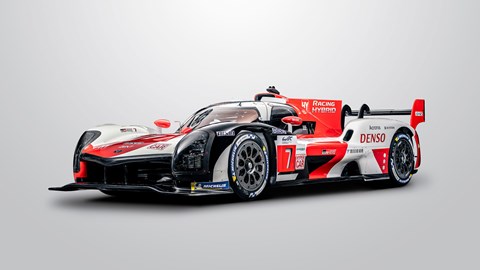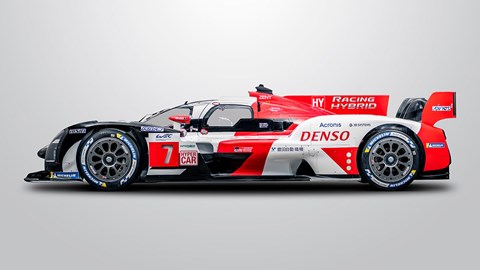► New Toyota hypercar
► Heavier, slower but cheaper
► Capped to 670bhp at all times
Meet the Toyota GR010 Hybrid, our first look at the WEC’s new hypercar class. Developed over the last year and a half, its chassis was designed by Gazoo Racing in Cologne, Germany, while its powertrain was developed in Higashi-Fuji, Japan.
Like last year, the #7 and #8 cars will be driven in 2021 by a stacked team of drivers, all of them among the safest pairs of hands you’ll find in one of the most unpredictable races in the world. Mike Conway, Kamui Kobayashi and José María López will share the #7 car, while Sébastien Buemi, Kazuki Nakajima and Brendon Hartley take the wheel of the #8 car. The season kicks off in March.
‘Endurance racing has always been a proving ground for new technology and now it is even more road car relevant,’ said Hartley. ‘The GR010 Hybrid previews a car which the end user will experience on the road.
It’s great to drive too, particularly with the hybrid four-wheel drive, which is a nice sensation from a driver’s perspective. The big difference is the extra weight and a bit less horsepower and downforce, but it’s still just as much fun to drive as the TS050 Hybrid.’
Scratch the surface of Toyota’s familiar-looking paintjob, and the GR010 is very different animal to the car that won Le Mans 2020. It’s the first fruits of the WEC’s new hypercar class, the same one Peugeot will enter in the next few years – and similar to the LMDh class Porsche is set to join in 2023. They’ll all eventually line up on the same grid, though.

Give me some specs
The GR010 is a hybrid and uses a 3.5-litre V6 twin-turbo to send 670bhp (500kW) to the rear wheels and combines it with an 268bhp (200kW) electric motor on the front axle. The new hypercar rules fix combined power output at 670bhp, so sometimes the GR010 will produce its grunt solely from the back tyres and petrol power, and at other times it’ll be four-wheel drive, with hybrid assistance. Electric power can only come in above 120km/h (75mph) under the class rules.
The GR010 has no rear-mounted MGU (motor generator unit), which means Toyota has had to fit hydraulic rear brakes and a starter motor. The petrol engine in the GR010 has also grown to 3.5 litres from the TS050’s compact 2.4-litre unit. If that sounds less sophisticated than the outgoing car, which had an MGU at the rear axle, that’s because it is; these rules were designed to cut costs after all. The new powertrain regulations mean the GR010 develops 32% less power than the previous car.

Penny-pitching means the new Toyota race car has also put on weight; it’s 162kg heavier, 250mm longer, 100mm wider and 100mm higher. Aero has been pared back too; the GR010’s rear wing will be the sole piece of adjustable aero – a world away from the TS050 that ran with high- or low-downforce bodywork panels.
The sum of these changes is a car that’s ten second slower around Le Mans than the car it replaces – but the thinking is that it’ll be part of a much healthier, more sustainable and varied grid. And if things get too predictable, the WEC also has the ability to equalise the competitiveness of the field with race-by-race Balance of Performance rules, which we can’t see causing any controversy…